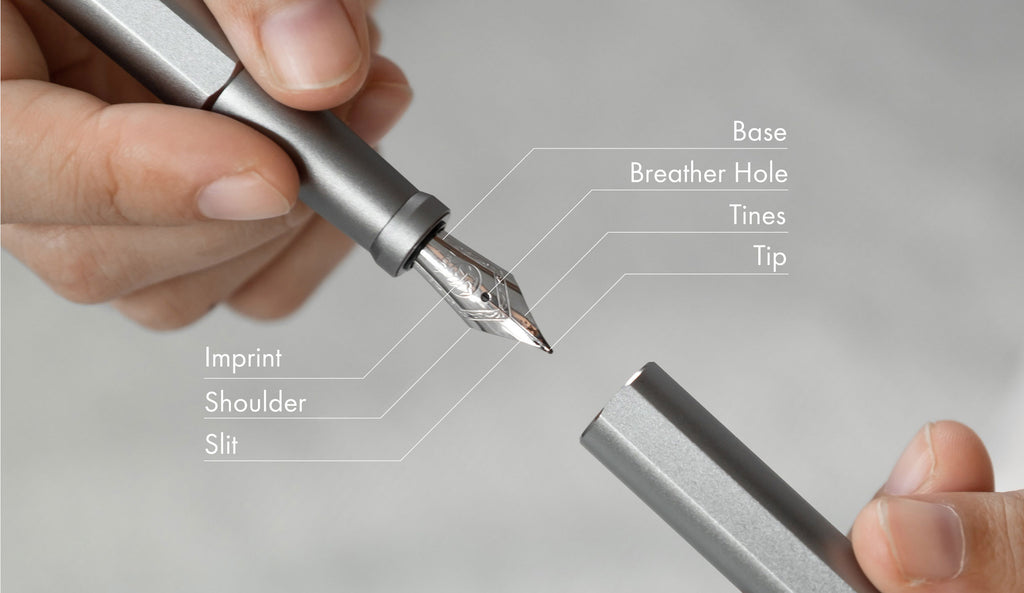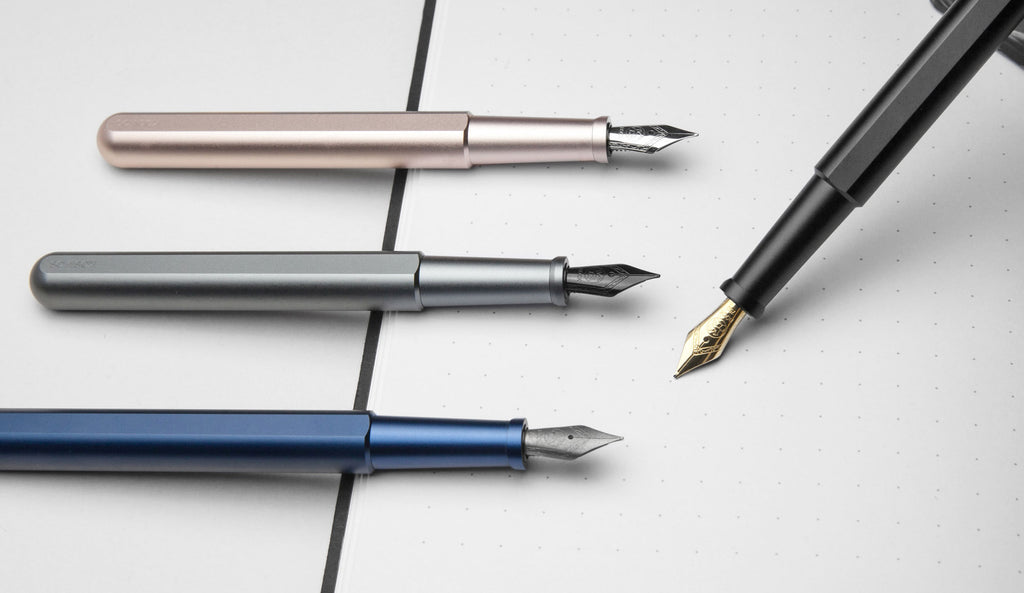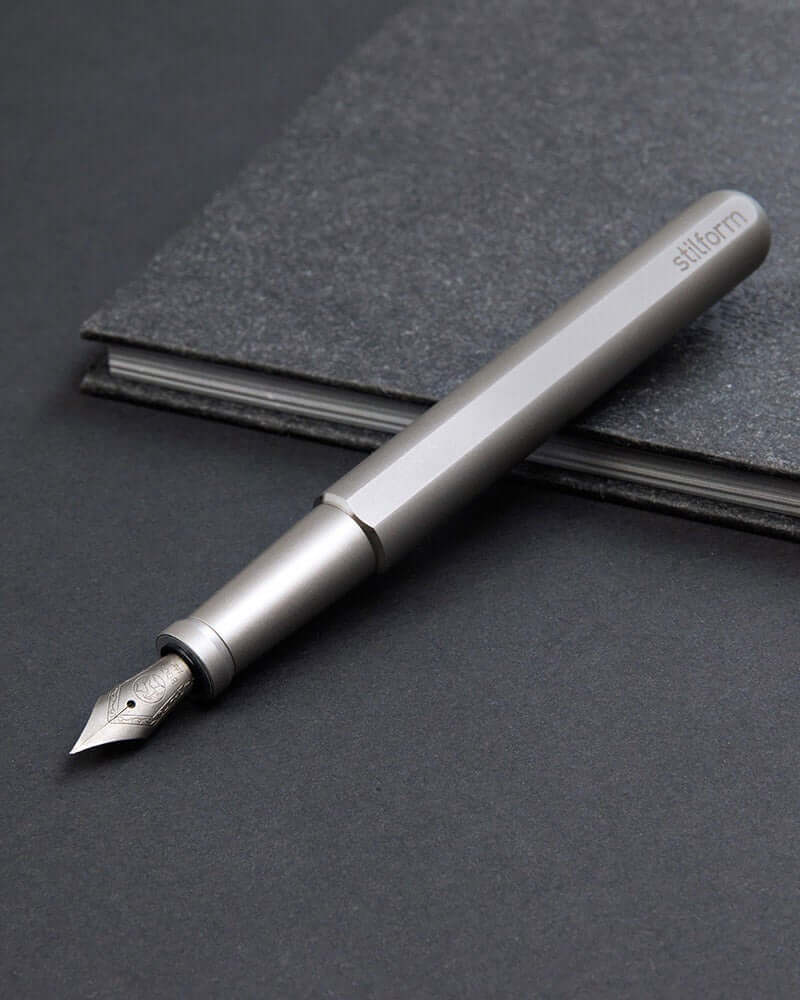Ein Füllfederhalter besteht aus vielen Einzelteilen. Für jemanden, der sich in der Welt der Füllfederhalter noch nicht auskennt, klingen diese Teile möglicherweise sehr verwirrend und beängstigend. Aber wenn Sie erst einmal jedes einzelne Teil eines Füllfederhalters und seine Funktion kennen, wird Ihnen alles ganz einfach erscheinen. Ein Füllfederhalter besteht aus sechs Hauptteilen: der Kappe, dem Schaft, der Feder, dem Tintenleiter, dem Griff und dem Konverter/der Patrone. In diesem Artikel erfahren Sie mehr über diese Teile und ihre Funktionen sowie über den neuen INK-Füllfederhalter von Stilform .
Die Kappe – die mit dem versteckten Trick
Die Kappe ist der Teil des Stifts, der die Feder bedeckt und am Stiftkörper befestigt ist. Eine Stiftkappe hat traditionell zwei Funktionen: Sie schützt die Feder vor versehentlichen Stößen und Abrollen und verhindert einen versehentlichen Kontakt der Feder mit der Außenseite, wodurch Leckagen vermieden werden.
Der Füllfederhalter INK von Stilform verfügt über eine innovative Kappe mit selbstausrichtendem Magnetmechanismus. Zum Öffnen und Schließen der Kappe müssen Sie sie nur einmal drehen, und sie wird durch eine starke Magnetkraft automatisch abgestoßen. Diese einzigartige Kappe verfügt außerdem über einen aufsteckbaren Clip , der durch Metallspritzguss hergestellt wurde und fest in den Stift gleitet, ohne Kratzer zu verursachen.

Der Lauf – der mit Anti-Roll-Design
Der Schaft ist der Körper des Stifts und der größte und längste Teil des Stifts. Er beherbergt den Tintenbehälter, stützt die Gesamtstruktur und bedeckt die Patrone.
Der Korpus des INK-Füllfederhalters weist ein schlankes und minimalistisches Design auf und verfügt über Anti-Roll-Eigenschaften aufgrund ausgerichteter flacher Seiten und scharfer Kanten.

Die Feder – die höchst anpassbare
Die Feder ist die Metallspitze eines Füllfederhalters, die das Papier berührt. Eine Feder enthält außerdem mehrere Komponenten:
- Spitzenmaterial - das kleine Stück strapazierfähiges Metall, das an das Ende einer Feder geschweißt ist
- Zinken - zwei vordere Teile der Feder, die sich zur Spitze hin verjüngen
- Entlüftungsloch - das Loch am Ende des Federschlitzes, durch das Luft einströmen kann, um den Tintenfluss zu unterstützen
- Schlitz - der dünne Schnitt, der sich vom Entlüftungsloch bis zur Spitze der Feder erstreckt und die Tinte durch Kapillarwirkung von der Zuleitung zur Spitze leitet
- Schulter - der breiteste Teil einer Feder, wo sie sich zur Spitze hin verjüngt
- Aufdruck - die Gravur auf der Vorderseite der Feder, die die Marke, das Modell oder die Federgröße angibt
- Basis - das hintere Ende der Spitze, wo die Feder den Abschnitt eines Stifts befestigt

Traditionell wurden Füllfederspitzen aus Gold gefertigt, da es flexibel und korrosionsbeständig war. Die meisten modernen Federn werden jedoch aus Edelstahl oder Goldlegierungen gefertigt, da diese robuster und langlebiger sind. Federn gibt es außerdem in verschiedenen Härtegraden und Spitzenformen.
Der Feed – das Wesentliche
Der Zuführer ist das Kunststoffteil, das die Unterseite der Feder berührt. Er spielt bei einem Füllfederhalter eine sehr wichtige Rolle, denn er sorgt dafür, dass die Tinte vom Reservoir zur Feder gelangt und dass Luft das Reservoir füllt. Wenn ein Füllfederhalter gut funktioniert, liegt das daran, dass der Zuführer richtig funktioniert.

Die Federeinheiten von Stilform (Peter Bock-Feder 076) sind für ihre zuverlässige Tinte bekannt. Sie sind in Edelstahl , schwarz lackiertem Edelstahl , Titan oder 14-karätigem Gold erhältlich. Außerdem sind sie in vier Größen erhältlich: extrafein (EF), fein (F), mittel (M), breit (B). Ihre Schulterbreite beträgt 8,0 – 8,4 mm und die sichtbare Federlänge beträgt 19,6 mm. Der Tintenleiter sorgt für einen zuverlässigen Tintenfluss und gewährleistet ein reibungsloses Schreibgefühl.

Der Griff/Abschnitt – Die Garantie für komfortables Schreiben
Der Griff ist der Teil, in den die Feder passt und der am Schaft des Stifts befestigt ist. Es ist der letzte Block der Stiftspitze und der Punkt, an dem die Feder und der Zuführer eingesetzt werden. Es ist auch der häufigste Griffpunkt des Stifts beim Schreiben. Die Vorderseite des Abschnitts, in den die Feder passt, wird als Griff bezeichnet, während die dünnen Rillen im Stift, die Teile zusammenhalten, als Gewinde bezeichnet werden.
Der einzigartige Magnetmechanismus des Füllfederhalters INK von Stilform macht Gewinde überflüssig und sorgt für eine bequeme Halteposition. Der Stift ist außerdem gut ausbalanciert und langes Schreiben mit dem Stift führt nicht zu Ermüdungserscheinungen.
Die Patrone und der Konverter – Holen Sie sich Ihre Lieblingstinte
Eine Patrone ist ein kleines, versiegeltes Einweg-Kunststoffröhrchen, in dem sich die Tintenversorgung des Füllfederhalters befindet. Wenn die Tinte aufgebraucht ist, müssen Sie die gebrauchte Patrone entfernen und eine neue einsetzen. Die Patrone ist der häufigste Tintenbehältertyp in modernen Füllfederhaltern. Der Hauptnachteil von Patronen besteht darin, dass Sie nur Patronen verwenden können, die für Ihren speziellen Stift hergestellt wurden. Dadurch ist Ihre Tintenauswahl eingeschränkt. Ein weiterer Nachteil ist der Preis. Obwohl Patronen nicht sehr teuer sind, können Sie mit einem Konverter auf lange Sicht Geld sparen.
Ein Konverter sieht einer Patrone sehr ähnlich und kann mit den meisten Patronenstiften verwendet werden. Der Konverter verfügt über einen Füllmechanismus, der das Nachfüllen mit Tinte ermöglicht, sodass Sie eine Vielzahl von Tinten verwenden können.
Sie fragen sich immer noch, wie Sie eine Patrone oder einen Konverter auf den INK-Füllfederhalter montieren? Hier ist ein Anleitungsvideo, das Ihnen dabei helfen kann:
Der Stilform INK-Füllfederhalter ist mit allen internationalen Standardpatronen und -konvertern kompatibel. Sie können auch unseren Stilform-Konverter kaufen, der speziell für unseren Stilform-Füllfederhalter hergestellt wird. Dieser Konverter ist ganz einfach zu verwenden – Sie müssen nur den transparenten Knopf des Konverters drehen, um Tinte aus einer Flasche zu ziehen. Mit diesem benutzerfreundlichen Konverter sind Standardtintenpatronenfarben keine Einschränkung mehr.
Jetzt, da Sie alles über Füllfederhalter wissen, worauf warten Sie noch? Holen Sie sich Ihren Stilform INK Füllfederhalter und genießen Sie ein fantastisches Schreiberlebnis!











Teilen und 15 % Rabatt sichern!
Teile dieses Produkt einfach in einem der folgenden sozialen Netzwerke und erhalte 15 % Rabatt!